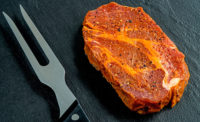Marinades add life, and challenges, to meat and poultry merchandising
More processors are injecting marinades into meat and poultry to create higher-margin items with added flavor, but operators must adhere to strict guidelines if they are to sustain quality and shopper interest.

The injection of marinades into proteins is adding spice to the often-dry meat and poultry merchandising sector. Many time-starved shoppers and consumers seeking convenient and exciting meals are willing to pay extra for the value-added selections that result in more tasty, juicy, and tender products, analysts note. More retailers, meanwhile, are using marinated meat and poultry as attractive differentiators that generate greater revenues and trigger larger basket sizes.
The share of consumers purchasing valued-added selections, which includes marinated proteins and prepared options like pre-seasoned and pre-cooked meats, rose from 37% in 2016 to 68% in 2021, states the Power of Meat 2021 report. The Power of Meat is published by the Arlington, Va.-based Food Marketing Institute and the Washington, D.C.-based Foundation for Meat & Poultry Research & Education, and prepared by 210 Analytics LLC, a San Antonio-based market research and marketing strategies firm.
“People are tired of the same-old, so offering something different can be a very welcoming change to their routine,” says Anne-Marie Roerink, 210 Analytics principal, adding that marinated meat as a center of the plate option also “inspires” the purchase of additional meal components.
To help generate greater meat and poultry sales, retailers are offering more unique marinade flavors, such as apple bourbon and zesty lemon and ginger, and Roerink notes that more seasonal and ethnic options and a wider variety of marinated products, ranging from rotisserie chicken to seafood, also is driving sales.
Yet, despite the popularity, a significant base of consumers still is wary of marinades, including many baby boomers who suspect that some merchandisers may be using marinades to disguise meats that are older or of poorer quality, Roerink says. Retailers can help alleviate the issue by listing such product information on packages as the date of development and the grade and cut of meat, she states.

A fine line between success and failure
To maintain quality, it also is critical that operators not inject too much, or too little, marinade into meat and poultry, says Norman Marriott, emeritus professor in the College of Agriculture and Life Sciences at Virginia Polytechnic Institute and State University (Virginia Tech), in Blacksburg. Not only can excessive or lower levels negatively impact flavor, but higher amounts of marinades can cause waste while processors risk exceeding regulatory mandates that govern the maximum amount of liquid solutions allowed in products, he states.
Having consistent levels of marinade throughout a cut also enhances the eating experience, Marriott notes, and is typically dependent upon the operating speed and injection rate of equipment.
“Needles that penetrate meat and poultry too many times add excessive solutions, causing product adulteration,” and can result in consumers paying a higher than necessary price for the meat because of the extra weight, he says. Ensuring that injection needles are the proper size and contain the appropriate number of holes for dispensing liquids is vital as well, Marriott states.
“If the conveyor goes too fast, there might not be enough marinade injected,” he says. “If it moves too slowly, there could be too much. That is where the proper design of equipment and machine adjustment and coordination comes in.”
The optimal needle length and width will vary in accordance with the type and size of the product undergoing injection, Marriott states, noting, for instance, that the requirements for thick ham differ from those for thin-sliced bacon.
In addition to ensuring systems are operating efficiently, processors must thoroughly clean and maintain the equipment to prevent the accumulation of microorganisms that can result in spoilage or foodborne illness, he says, which necessitates training and supervising employees on the most effective sanitary methods.
Artwork
pork tenderloin images courtesy of Smithfield Foods
Looking for a reprint of this article?
From high-res PDFs to custom plaques, order your copy today!









